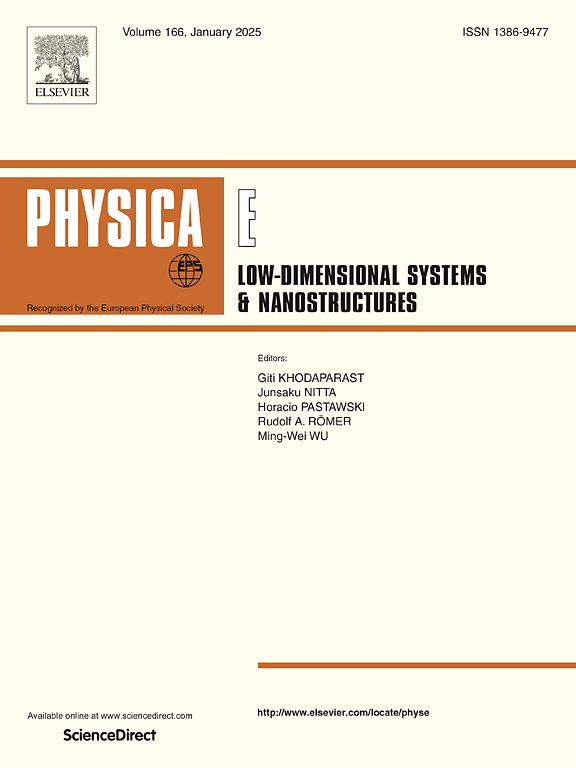Electronic properties of semimagnetic double quantum wells under effects of magnetic field and temperature
IF 2.9
3区 物理与天体物理
Q3 NANOSCIENCE & NANOTECHNOLOGY
Physica E-low-dimensional Systems & Nanostructures
Pub Date : 2025-04-24
DOI:10.1016/j.physe.2025.116274
引用次数: 0
Abstract
This study examines the electronic characteristics of a diluted magnetic semiconductor double quantum well (DQW) based on the system. Through an in-depth analysis, it assesses how various parameters including the well width (), impurity position (), magnetic field intensity (), and temperature () affect the binding energy () and diamagnetic susceptibility (). Additionally, the investigation considers the spin polaronic shift (), taking into account the same influencing factors. The findings demonstrate that an increasing magnetic field leads to a reduction in , particularly when the impurity is positioned at the center of the well in a semimagnetic DQW structure. Furthermore, the results indicate that a rise in temperature also diminishes . Interestingly, temperature and magnetic field exhibit opposing effects on the spin polaronic shift. Moreover, the is found to be dependent on the impurity location, DQW geometry, applied magnetic field, and temperature.
磁场和温度作用下半磁双量子阱的电子特性
本研究考察了基于CdTe/Cd1−xMnxTe体系的稀释磁性半导体双量子阱(DQW)的电子特性。通过深入分析,评估了井宽(Lw)、杂质位置(zi)、磁场强度(γ)和温度(T)等参数对结合能(Eb)和抗磁化率(χdia)的影响。此外,研究考虑了自旋极移(Esp),考虑了相同的影响因素。结果表明,在半磁DQW结构中,当杂质位于井的中心时,增加的磁场会导致Eb的减少。此外,结果表明,温度的升高也降低了Eb。有趣的是,温度和磁场对自旋极移表现出相反的影响。此外,发现χdia与杂质位置、DQW几何形状、外加磁场和温度有关。
本文章由计算机程序翻译,如有差异,请以英文原文为准。
求助全文
约1分钟内获得全文
求助全文
来源期刊
CiteScore
7.30
自引率
6.10%
发文量
356
审稿时长
65 days
期刊介绍:
Physica E: Low-dimensional systems and nanostructures contains papers and invited review articles on the fundamental and applied aspects of physics in low-dimensional electron systems, in semiconductor heterostructures, oxide interfaces, quantum wells and superlattices, quantum wires and dots, novel quantum states of matter such as topological insulators, and Weyl semimetals.
Both theoretical and experimental contributions are invited. Topics suitable for publication in this journal include spin related phenomena, optical and transport properties, many-body effects, integer and fractional quantum Hall effects, quantum spin Hall effect, single electron effects and devices, Majorana fermions, and other novel phenomena.
Keywords:
• topological insulators/superconductors, majorana fermions, Wyel semimetals;
• quantum and neuromorphic computing/quantum information physics and devices based on low dimensional systems;
• layered superconductivity, low dimensional systems with superconducting proximity effect;
• 2D materials such as transition metal dichalcogenides;
• oxide heterostructures including ZnO, SrTiO3 etc;
• carbon nanostructures (graphene, carbon nanotubes, diamond NV center, etc.)
• quantum wells and superlattices;
• quantum Hall effect, quantum spin Hall effect, quantum anomalous Hall effect;
• optical- and phonons-related phenomena;
• magnetic-semiconductor structures;
• charge/spin-, magnon-, skyrmion-, Cooper pair- and majorana fermion- transport and tunneling;
• ultra-fast nonlinear optical phenomena;
• novel devices and applications (such as high performance sensor, solar cell, etc);
• novel growth and fabrication techniques for nanostructures

 求助内容:
求助内容: 应助结果提醒方式:
应助结果提醒方式:


